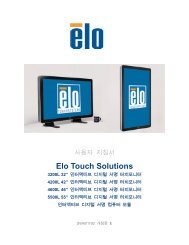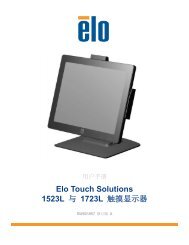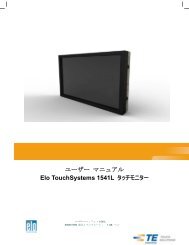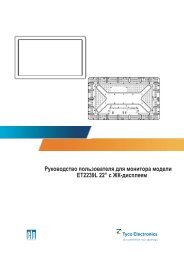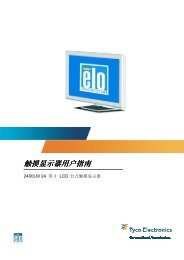AccuTouch Product Guide - Elo TouchSystems
AccuTouch Product Guide - Elo TouchSystems
AccuTouch Product Guide - Elo TouchSystems
Create successful ePaper yourself
Turn your PDF publications into a flip-book with our unique Google optimized e-Paper software.
CHAPTER 4GLOSSARY<br />
A<br />
Autosizing-True autosizing occurs when a monitor can maintain a constant<br />
image size across different video modes. Two common ways of achieving<br />
autosizing are mode sensing, pre-programmed factory settings and user defined<br />
modes.<br />
B<br />
Bandwidth-The range of frequencies over which the video display’s electronics<br />
can respond. This is directly related to the speed at which the monitor can<br />
accept pixel information and to the maximum resolution the monitor can<br />
display.<br />
Barrel-A type of distortion in which an images’s sides or top (or both) appear to<br />
bulge outward.<br />
Blooming-When image brightness increases, the CRT’s electron beam tends to<br />
spread out and lose focus. This loss of focus on bright portions of an image<br />
makes the image appear to expand or “bloom”, and lose detail.<br />
Bow-A type of distortion in which opposite sides of the screen image curve in<br />
the same direction.<br />
C<br />
Convergence-The ability of the monitor to correctly align the red, green and<br />
blue components of an image on the screen. Convergence problems are often<br />
visible as fringes of color at the edge of the screen or color around text or<br />
graphics where it should be white.<br />
CRT-An acronym for cathode ray tube. A type of display in which images are<br />
created by electron beams that caused the glowing of phosphors inside the<br />
surface of a glass screen.<br />
D<br />
DAF-Dynamic Astigmatism Focus. A technique using a quadruple lens to focus<br />
the electron beams horizontally and diffuse it vertically.<br />
Dot Pitch-The distance between a phosphor dot and the next nearest dot of the<br />
same color on a CRT, expressed in millimeters. The dot pitch does not<br />
correspond to the display resolution in pixels. Instead, the CRT’s electron beam<br />
hits one or more phosphor dots to create a pixel. Monitors with smaller dot<br />
pitches generally produce sharper images because smaller phosphor dots can be<br />
used to represent each pixel more accurately.<br />
Glossary-99





